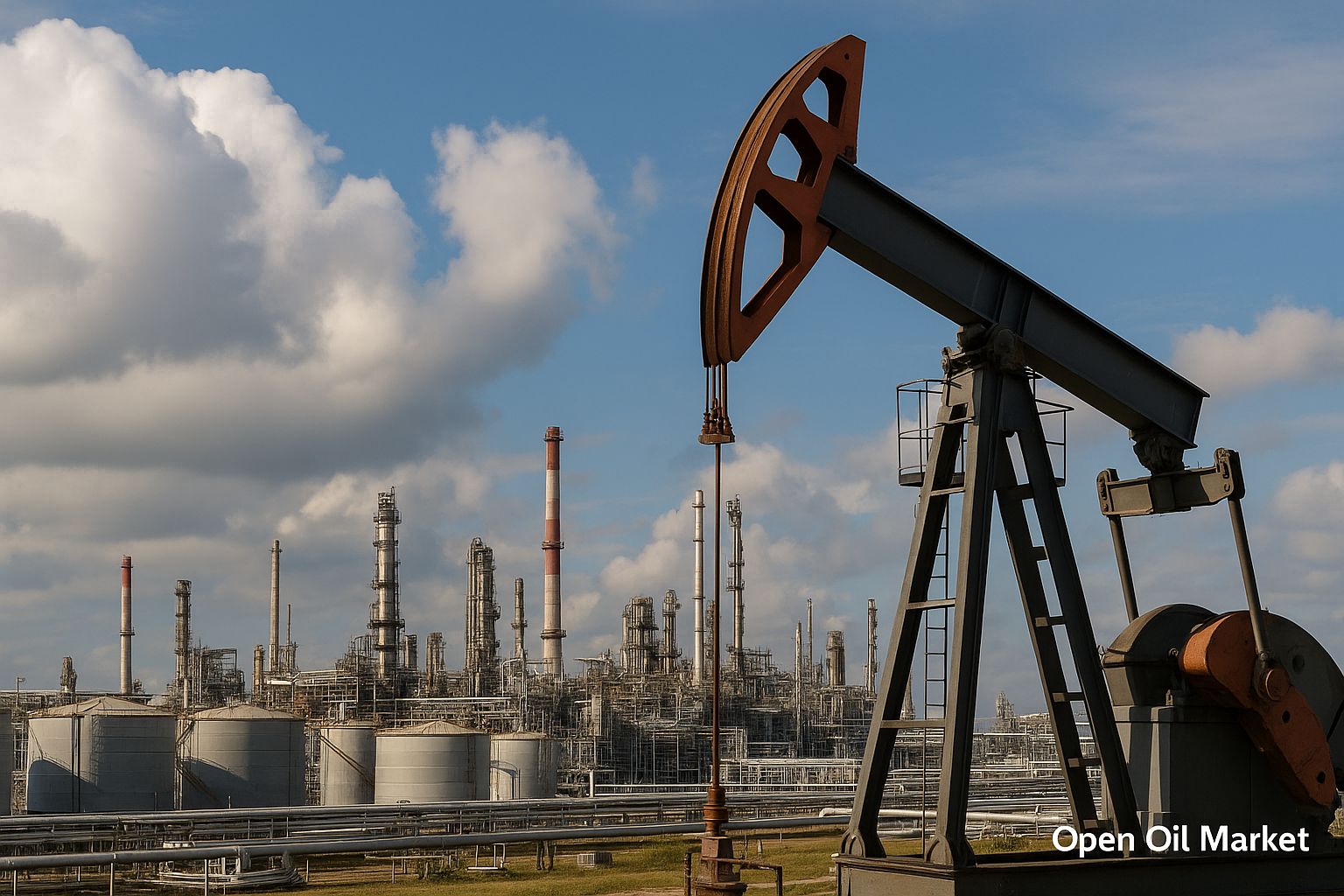Main News of the Oil, Gas, and Energy Sector as of November 17, 2025: Sanctions Shift Trade Flows, Cold Weather Affects Gas Supplies, Renewable Energy Share Increases. Analysis of Trends and Forecasts for Investors and Industry Participants.
Current events in the fuel and energy complex on November 17, 2025, are unfolding against a backdrop of conflicting trends, capturing the attention of investors and market participants. Geopolitical tensions remain high, as the West expands sanctions against the Russian oil and gas sector, forcing a realignment of hydrocarbon trade flows. Simultaneously, some conflicts exhibit signs of de-escalation—an ongoing ceasefire in the Middle East and a temporary trade truce between the U.S. and China enhance global demand forecasts. Oil prices have stabilized at moderate levels after a recent decline, while the European gas market enters winter with comfortable albeit reduced supplies; cold weather poses a potential threat. The global energy transition is gaining momentum, with record investments in renewable energy, although oil, gas, and coal remain the backbone of the world’s energy supply. In Russia, emergency measures have normalized the domestic fuel market following a recent crisis. Below is a detailed overview of the key segments of the fuel and energy complex—oil, gas, electricity, coal, and renewable sectors, as well as the market for petroleum products and refining—highlighting the main trends and factors influencing the industry as of the current date.
Oil Market: Surplus Persists, Export Flows Shift
The global oil market continues to balance in a state of fragile equilibrium. By mid-November, oil prices have stabilized after an autumn decline: North Sea Brent is trading around $63–65 per barrel, while U.S. WTI is near $59–61. These levels are significantly below summer peaks, approximately 10% lower than values from a month ago, reflecting expectations of a surplus at the end of the year. Traders are operating under the scenario that supply in Q4 will exceed demand, limiting price increases. At the same time, factors are in play that prevent prices from falling sharply—as the market is addressing sanction risks and potential supply disruptions.
- Production Growth Amid Slowing Demand. OPEC+ countries are scheduled to increase oil production (an expected increase of 137,000 barrels per day in December, followed by a pause until April). Outside the alliance, major producers such as the U.S., Brazil, and others have reached record production levels, ramping up supply. However, global oil consumption growth is slowing: recent forecasts indicate that global demand will increase by less than 0.8 million barrels per day in 2025 (compared to a growth of 2 million barrels per day in 2023), due to an economic slowdown and energy-saving measures.
- Sanctions and Redistribution of Flows. New U.S. and U.K. sanctions against subsidiaries of major Russian oil companies (such as Rosneft and LUKOIL) come into effect, complicating the export of Russian oil. Moscow is forced to redirect supplies to alternative markets. Under pressure from Western partners, Indian refiners have expressed their readiness to significantly reduce the purchase of Russian oil starting at the end of November to comply with sanction restrictions. The potential loss of one of the key buyers—India—could radically restructure global crude flows, intensifying competition for markets. Russian exporters are already offering crude at steeper discounts, attempting to retain Asian clients.
- Geopolitical Risks Support Prices. Military conflicts continue to threaten the stability of energy supplies. The confrontation over Ukraine remains unresolved; in mid-November, a Ukrainian drone attack on the Novorossiysk port damaged oil infrastructure, causing a temporary halt in shipments and a price spike of over 2%. Tensions in the Middle East have eased slightly due to a ceasefire; however, the situation remains fragile. Such risks create a sort of “geopolitical premium” in the market, preventing prices from dropping any further.
Gas Market: Buffer Stock and Cold Weather Testing
The situation in the gas market is defined by seasonal balancing between high stock levels and weather challenges. Europe is entering the heating season with underground storage filled to an average of ~80–82%—noticeably lower than the record 92% a year ago, but still providing a significant buffer. Thanks to a mild autumn, European gas prices recently dipped to comfortable lows: the foundational TTF futures recently fell to around ~30 € per MWh (approximately $10 per million BTU), marking the lowest levels since spring 2024. However, the anticipated cold weather is returning volatility to the market, as prices have started to rebound with the approach of winter frost.
- High Stocks vs. Rising Consumption. Meteorologists are warning of a sharp drop in temperatures in Western Europe (5–7 °C below normal), which will significantly increase gas consumption for heating over the coming week. If the winter proves harsh and prolonged, European stocks could deplete faster than usual, triggering a new wave of price increases and forcing an increase in gas imports.
- The Role of LNG in the Balance. Liquefied natural gas remains a key source for meeting EU demand following a sharp reduction in pipeline supplies from Russia. LNG imports into Europe remain high, supported by record exports from the U.S., Qatar, and other producers. Demand for gas in Asia remains moderate; China's economic slowdown and filled storage in East Asia mean there was virtually no competition between Europe and Asia for LNG this autumn. This balance in the global LNG market has helped prevent sharp price spikes in Europe.
Electric Power: Record Renewables and Grid Reliability
The global electricity sector is undergoing major structural changes, marked by the increasing share of renewables and modernization of energy grids. Throughout 2025, many countries have reported record electricity generation from renewable sources, gradually displacing coal generation. Analysts estimate that in the first half of 2025, global generation from renewables has surpass coal for the first time. In several developed nations, the share of solar and wind energy has reached 80–100% of consumption at certain times (in specific hours in Europe). Similar trends are observed in major economies in Asia (China, India) and North America (the U.S., Canada), indicating the progress of the global energy transition. At the same time, such rapid growth in renewables presents new challenges for ensuring the reliability of energy systems during the transition period.
- Reliability of Energy Supply. The variable nature of wind and solar generation necessitates accelerated development of energy storage systems and reserve capacities. Gas and coal plants are still used to cover peak loads during winter hours, although their role is gradually diminishing. In countries with well-developed energy systems, it is expected that available reserve capacities will suffice even during abnormal cold weather, although during peak periods, there may be price increases for electricity. Energy companies are actively investing in modernizing grids and industrial storage systems to maintain reliability of energy supply as the share of renewables grows.
- Government Policies and New Technologies. Governments around the world are supporting the trend toward decarbonizing energy. The European Union has set new ambitious targets for renewable energy shares by 2030; China and India are implementing large-scale programs to build solar and wind power plants; while the U.S. is implementing updated incentives for clean energy. Concurrently, interest in ‘clean’ nuclear and hydrogen technologies is growing as key elements of future energy systems. Thus, the energy sector is moving towards a more sustainable model: ‘green’ capacities are increasing, infrastructure is being updated, and measures are taking place to ensure stability of energy supply during the transition period.
Coal Sector: Demand on Plateau, Surplus Pressuring Prices
A turning point has emerged in the coal industry: global demand has stabilized around historical peaks and is starting to gradually decline while production remains high. Traditional industry markets are feeling the growing pressure from environmental regulations and competition from cheap renewables.
- Peak Consumption Achieved. Global coal consumption is estimated to have reached a record ~8.8 billion tons in 2024, but growth has halted in 2025. Global forecasts indicate a move to a ‘plateau’ in 2025–2026, followed by an expected decline in demand as climate policies tighten and renewable energy development accelerates.
- Supply Surplus and Price Decline. Coal production is still at maximum levels, leading to a surplus of supplies in the market. World coal prices have dropped to minimum levels over the past few years, reducing the profitability of coal companies. Exporters with high costs (including some Russian companies) are facing particularly tough challenges. The market is responding, with many producers forced to cut back on production and investments to adapt to the new realities.
Refining and Fuel Market: Market Stabilization and Price Control
Following the turbulence at the start of autumn, the global petroleum products market is showing signs of stabilization. The decline in oil prices and seasonal drop in fuel demand (with the end of the summer driving season) have allowed refineries to increase output and replenish gasoline and diesel stocks. In Europe and the U.S., wholesale prices for petroleum products have retreated from September peaks, leading to moderate reductions in fuel prices for end consumers. The situation in Russia's domestic market, which experienced a severe gasoline shortage in September, has also normalized due to emergency measures taken by the authorities.
- Crisis Measures in Russia. The Russian government temporarily banned the export of gasoline and diesel fuel, while also increasing subsidies for refiners to direct more resources to the domestic market. These steps quickly eliminated the deficit: fuel production returned to previous levels, gas stations were supplied with fuel, and wholesale prices fell. Authorities have stated their intention to gradually lift export restrictions as market stability is established.
- Global Stabilization of Fuel Prices. This autumn, the global petroleum products market received a respite. Increased gasoline and diesel exports from OPEC and Asian countries partially offset the volumes lost from Russia, while the seasonal drop in demand allowed fuel stocks to be replenished. Prices for gasoline and diesel in major regions have returned to early summer levels: fuel has significantly decreased in Europe and the U.S. compared to September highs. It is expected that diesel and heating fuel consumption will traditionally rise in winter; however, with stable oil prices, sharp price increases for petroleum products are not anticipated.




